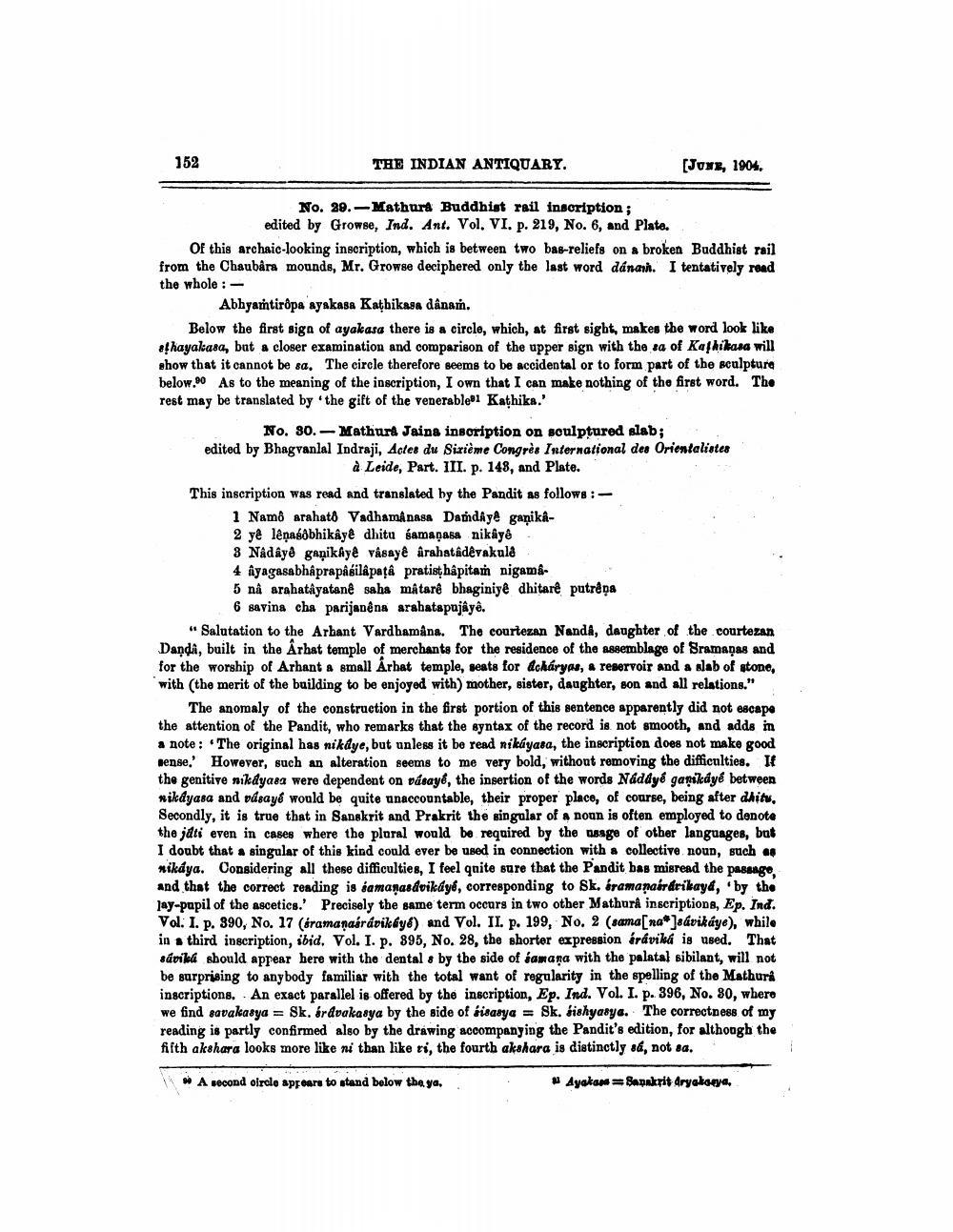________________
152
THE INDIAN ANTIQUARY.
(JUNE, 1904,
No. 29.-Mathura Buddhist rail inscription;
edited by Growse, Ind. Ant. Vol. VI. p. 219, No. 6, and Plate. Of this archaic-looking inscription, which is between two bas-reliefs on a broken Buddhist rail from the Chaubara mounds, Mr. Growse deciphered only the last word dánann. I tentatively read the whole :
Abbyartirðpa ayakasa Kathikasa dânań. Below the first siga of ayakasa there is a circle, which, at first sight, makes the word look like afhayakasa, but a closer examination and comparison of the upper sign with the sa of Kaskikasa will show that it cannot be sa. The circle therefore seems to be accidental or to form part of the sculpture below.90 As to the meaning of the inscription, I own that I can make nothing of the first word. The Test may be translated by the gift of the venerableøl Kathika.'
No. 80.- Mathura Jaina inscription on sculptured slab; edited by Bhagvanlal Indraji, Actes du Sixième Congrès International des Orientalistes
à Leide, Part. III. p. 148, and Plate. This inscription was read and translated by the Pandit as follows:
1 Nam arahat8 Vadhamanasa Dandiyê ganika2 yê lêņasõbhikâye dhitu sama asa nikâye. 3 Nadâyê ganikâye vâsayê arahatâdêyakula 4 ayagasabhaprapabilậpatâ pratist hâpitam nigama5 nå arahatiyatanê saba mátarê bhaginiye dhitaré putrèņa
6 savina cha parijanêna arabatapajâyê. "Salutation to the Arbant Vardhamana. The courtezan NandA, daughter of the courtezan Danda, built in the Århat temple of merchants for the residence of the assemblage of Sramaņas and for the worship of Arhant a small Århat temple, seats for acharyas, e reservoir and a slab of stone, with the merit of the building to be enjoyed with) mother, sister, daughter, son and all relations."
The anomaly of the construction in the first portion of this sentence apparently did not escape the attention of the Pandit, who remarks that the syntax of the record is not smooth, and adds in a note : The original has nikdye, but unless it be read nikayasa, the inscription does not make good nense. However, such an alteration seems to me very bold, without removing the difficulties. It the genitive nikdyasa were dependent on vásayé, the insertion of the words Naddyé gamikdyê between nikdyasa and pdsayé would be quite unaccountable, their proper place, of course, being after dhitu, Secondly, it is true that in Sanskrit and Prakrit the singular of a noun is often employed to denote the jdti even in cases where the plural would be required by the neage of other languages, but I doubt that a singular of this kind could ever be used in connection with a collective noun, such as Nikdya. Considering all these difficulties, I feel quite sure that the Pandit bas misread the passage and that the correct reading is samanasdvikäyé, corresponding to Sk, éramanaárdrikaya, by the Jay-papil of the ascetics.' Precisely the same term occurs in two other Mathura inscriptione, Ep. Ind. Vol. I. p. 390, No. 17 (dramanaárávikkyl) and Vol. II. p. 199, No. 2 (sama[na*]sávikaye), while in a third inscription, ibid. Vol. I. p. 895, No. 28, the shorter expression árávika is used. That sávill should appear here with the dental & by the side of samana with the palatal sibilant, will not be surprising to anybody familiar with the total want of regularity in the spelling of the Mathura inscriptions. An exact parallel is offered by the inscription, Ep. Ind. Vol. I. p. 396, No. 80, where we find savakasya = $k. ár dvakasya by the side of tisasya = Sk. bishyasya. The correctness of my reading is partly confirmed also by the drawing accompanying the Pandit's edition, for although the fifth akshara looks more like ni than like ri, the fourth akshara is distinctly sá, not sa.
A second oircle appears to stand below thaya.
Ayakan
Sapukris Aryakaeya,




